MXA RACE TEST: 2017 KTM 250SX — THE TWO-STROKE STEPS UP
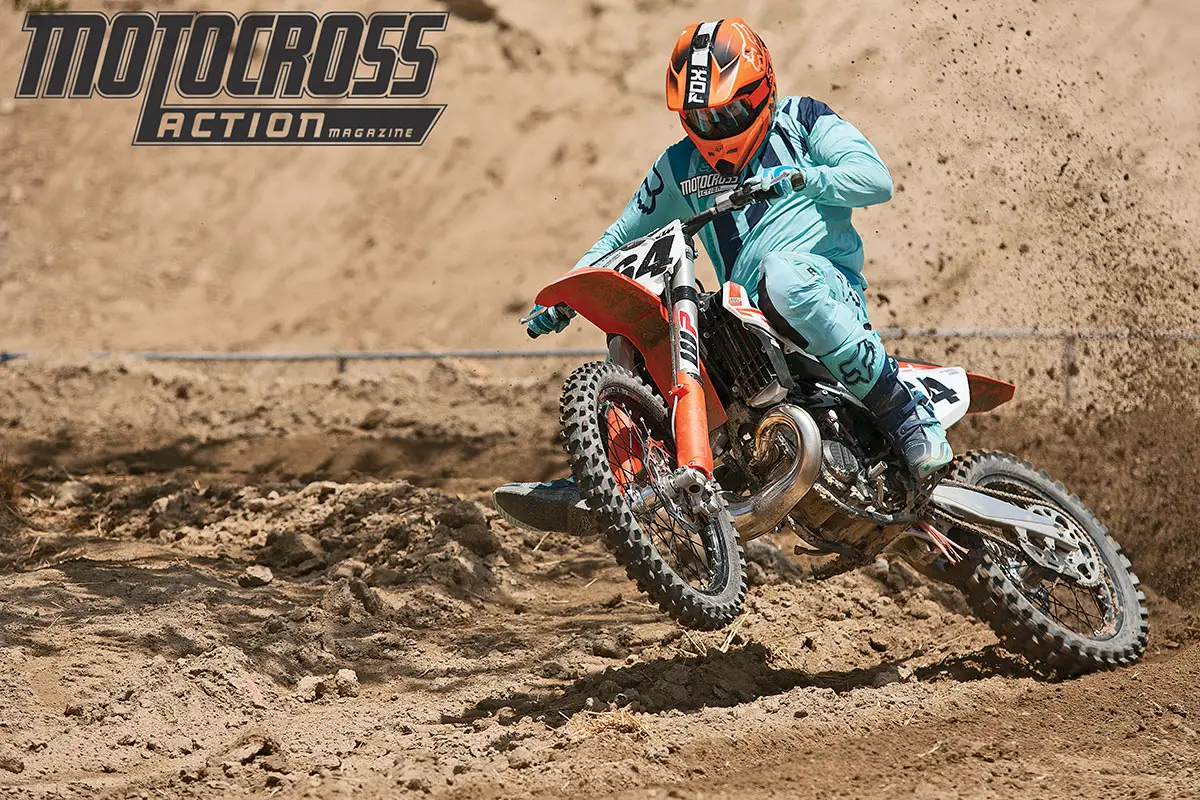
Q: FIRST AND FOREMOST, IS THE 2017 KTM 250SX BETTER THAN THE 2016 KTM 250SX?
A: MXA didn’t test a 250SX two-stroke in 2016. When we asked for one, KTM said, “We have a new bike coming in 2017. Just wait for that one.” Okay, we admit that they could have been a bit peeved that in our “2015 250 Two-Stroke Shootout” the MXA test riders determined that the decade-old Yamaha YZ250 was the king of the 250 class. Since the 2016 KTM 250SX was the 2015 model, KTM decided that it wasn’t worth the embarrassment to get beat by the old dog once again. Which begs the question, is the 2017 KTM 250SX better than the 2016 model? Yes, light years better.
Q: HOW MUCH DOES A 2017 KTM 250SX COST?
A: The 250SX has a price tag of $7699, while the TC250 costs $7799 and the YZ250 costs $7200.
Q: WHAT CHANGES DID KTM MAKE TO THE 2017 250SX CHASSIS?
A: For 2016 the 250SX was the only KTM motocross model that did not get upgraded to the new-generation chassis. Here is a recap of what KTM changed on all the other 2016 KTM models that got implemented into the 2017 250SX.
(1) Frame. The chromoly steel frame was lightened (0.8 pounds) and provides 20 percent more torsional rigidity and 30 percent less longitudinal stiffness.
(2) Geometry. The wheelbase has been shortened by 10mm and the head angle steepened by 0.4mm.
(3) Subframe. The aluminum subframe is smaller and 20 percent lighter.
(4) Swingarm. To the naked eye, the 2017 swingarm looks the same as the 2016 swingarm, but the internal structure has been revised to match the flex characteristics. It is lighter as well.
(5) Footpegs. The all-new, larger, more stable footpegs are a work of art. They utilize a scraper design to reduce dirt buildup in the hinge to keep them working properly.
(6) Airbox. The no-tools airbox has been updated to an even simpler design, and the filter is the first-ever plug-and-play design.
(7) Shock. The 250SX gets the latest-generation WP shock. It features a revised reservoir, new piston, new shock shaft and new clevis design that shortens the shock length by 12mm. The linkage is also an all-new design to fit the architecture of the new frame.
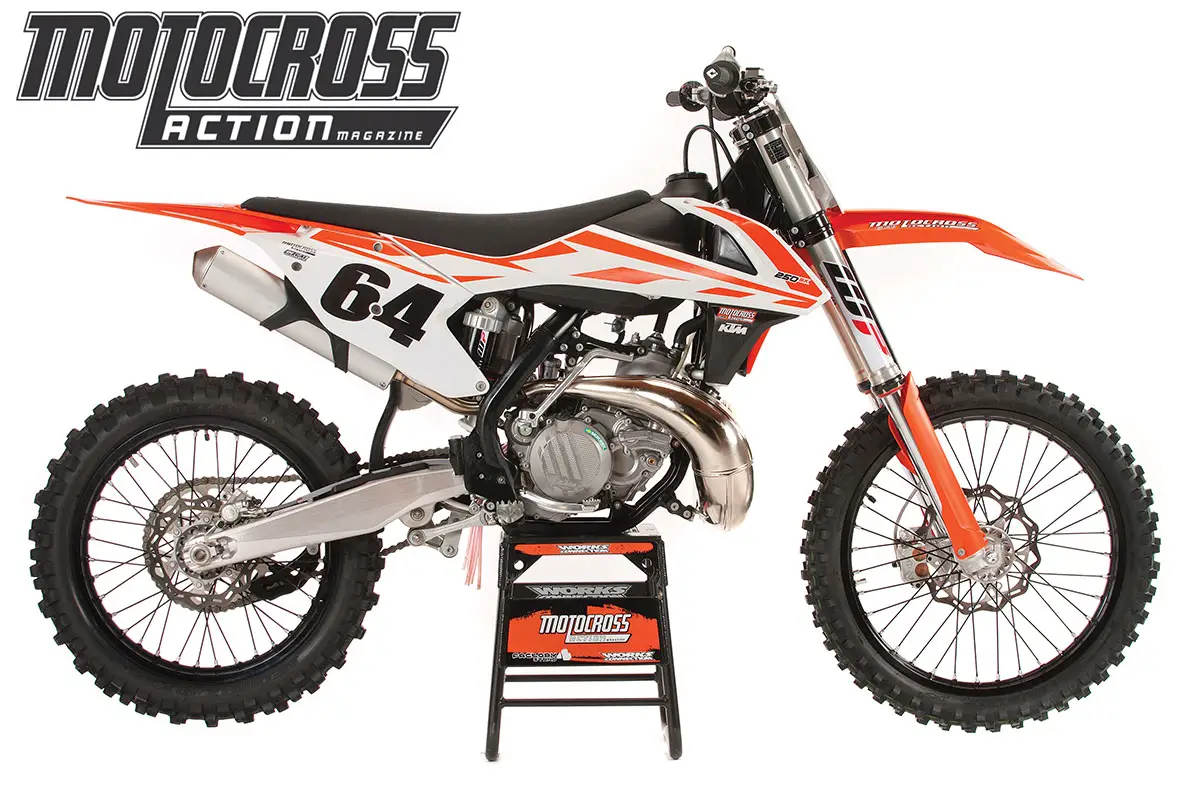
Q: WHAT ARE THE 2017 REFINEMENTS KTM MADE TO ITS MOTOCROSS LINE?
A: After a year of ironing the bugs out of KTM’s new chassis, for 2017 KTM made a few updates across the board to its motocross line.
(1) Forks. For 2017 KTM jumped on the air-fork bandwagon. The WP AER 48mm forks have a much simpler and user-friendly design than the Showa triple chamber or Kayaba PSF-2 forks.
(2) Brake pedal. For the last few years, MXA has replaced the KTM brake-pedal tip with a 7602 Racing tip to extend the pedal 10mm. For 2017 KTM lengthened the brake pedal by 10mm.
(3) Brake pads. It is a minor change, but it is worth mentioning that KTM felt its rear brake system was too aggressive. Riders complained that the rear brake was too touchy. They wanted increased modulation for better rear-end control. To accommodate the riders, KTM went with glazed-over brake pads. If you liked the aggressive feel, no problem—just replace the pads with the 2016 brake pads.
(4) Carburetor. After a 28-year relationship with Keihin, KTM jumped ship to Mikuni. For 2017 the entire KTM two-stroke lineup (125SX, 150SX, 250SX and 300XC) has been switched to Mikuni carburetors. The 250SX now comes with a 38mm Mikuni TMX carb.
(5) Triple clamps. To support the flex characteristics of the WP AER fork, a stiffer upper triple clamp was developed to increase rigidity.
(6) Bar mounts. In 2016 KTM went to rubber-mounted bar mounts to reduce vibration. With the bars’ ability to flex came a side effect—the handlebar mounts were prone to twisting in the clamps in crashes. MXA test riders mounted either Ride Engineering anti-twist bar mounts or the top bar clamp from a KTM Super Duke to fix the problem. For 2017 KTM beefed up the bar mounts by making a separated lower clamp and a bridge-style upper clamp. we still twisted the clamps in crashes.
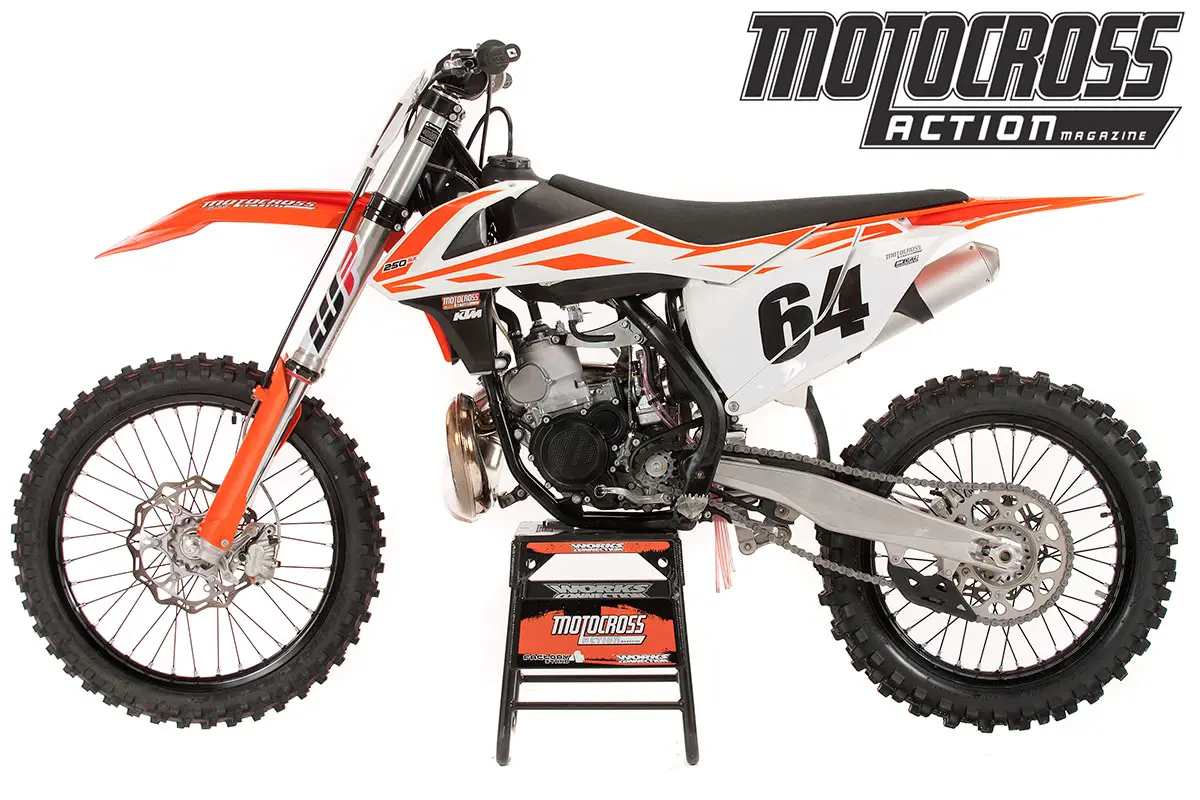
Q: WHAT CHANGES DID KTM MAKE TO THE ENGINE?
A: Let it be known, two-strokes are here to stay. The proof is in the pudding. KTM’s best-selling engine designs are its 250cc and 300cc two-strokes. This is why KTM is still pouring R&D money into its two-stroke line. The Japanese manufacturers have been left in the dark. For 2017 the entire 250SX engine has been overhauled, save for the bore and stroke (66.4mm by 72mm) and the five-speed close-ratio transmission. KTM’s goals with its new engine design were to centralize mass, reduce vibration and improve power. Here are the updates to the 250SX engine.
(1) Crankcase. The die-cast crankcase has been redesigned to accommodate a new counterbalancer shaft and to allow the clutch and crankcase to be closer to the center of gravity.
(2) Cylinder. The cylinder has new transfer and exhausts ports, a reworked power-valve system and an optimized water jacket.
(3) Cylinder head. The head has been reworked with brackets to connect two lateral headstays.
(4) Clutch. The 250SX’s DDS Belleville-washer clutch got the same upgrades as the 2017 KTM 450SXF unit.
Q: WHAT ELSE IS NEW ON THE 2017 KTM 250SX TWO-STROKE?
A: These are all updates made last year to the 125SX, 150SX, 250SXF, 350SXF and 450SXF; and for 2017, they have been applied to the 250SX.
(1) Bodywork. All the bodywork, from head to tail, is totally new. The front number plate incorporates the front brake-hose holder. The seat has a lower and flatter shape. An embossed sag line on the rear fender helps with accurate sag measurements.
(2) Radiators. The WP-built radiators are redesigned to be more efficient, allowing for better airflow and lower engine temperature. The radiator-guard design provides structural rigidity to the radiator. No more need for aftermarket radiator braces.
(3) Brakes. The Galfer Wave rotors are lighter than before.
(4) Tires. The 250SX comes shod with Dunlop Geomax MX3S tires.
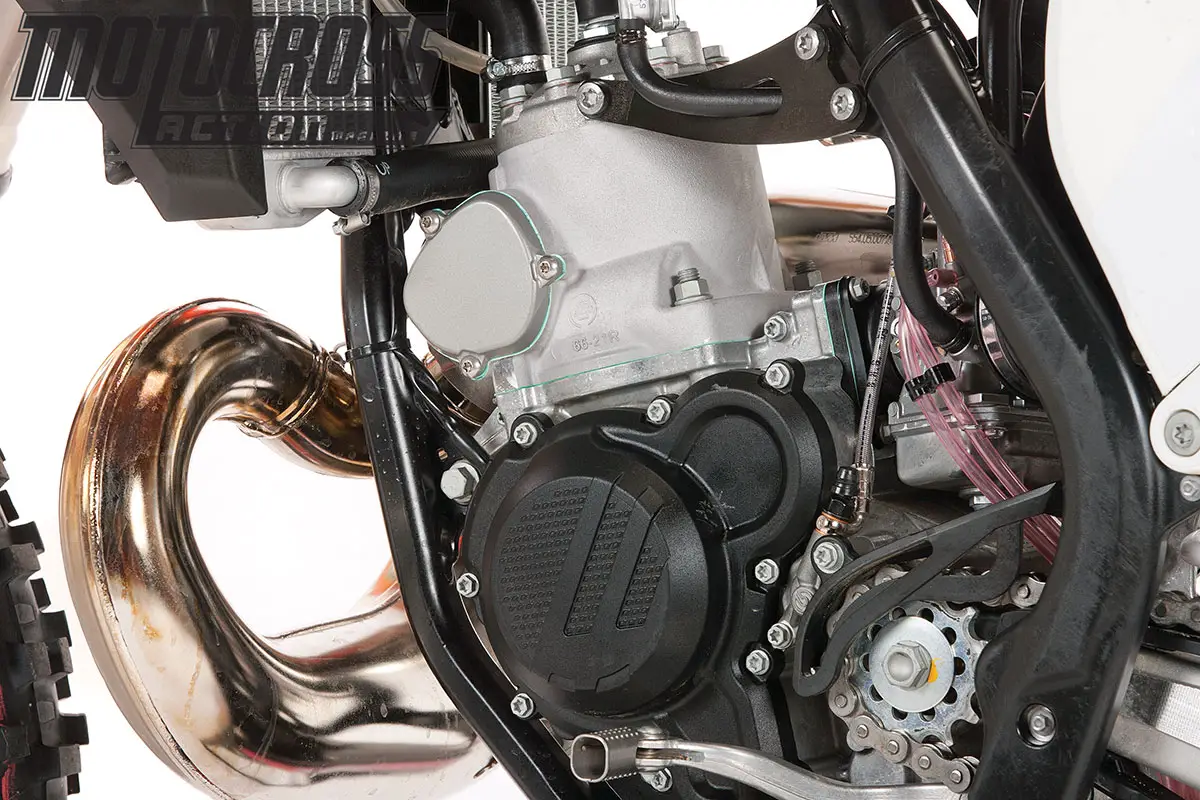
Q: HOW FAST IS THE 2017 KTM 250SX?
A: If we said it was too fast, would you think we were crazy? From the snap of the throttle to the midrange, the 250SX is blisteringly fast. It is fast, abrupt and hard-hitting enough to be hard to manage, especially for any rider making the transition from a four-stroke to the 250SX. The rear wheel would light up from even the slightest movement of the right wrist. With the increased power and the same transmission ratios as the year prior, the 250SX’s shift points, especially from second to third, were extremely short. The engine had ample power from mid to top, but it tipped over very quickly at sign-off. How quickly the power faded and required shifting made for awkward shift points out of the corners. Oh, don’t get us wrong; this gun-and-run style of power, with its need to shift on the bubble, was awesome for skilled two-stroke racers. It was just a little too high maintenance for the less skilled. Thankfully, we found a few simple changes that could alter the powerband and make it more linear—or even more abrupt if that’s your cup of tea.
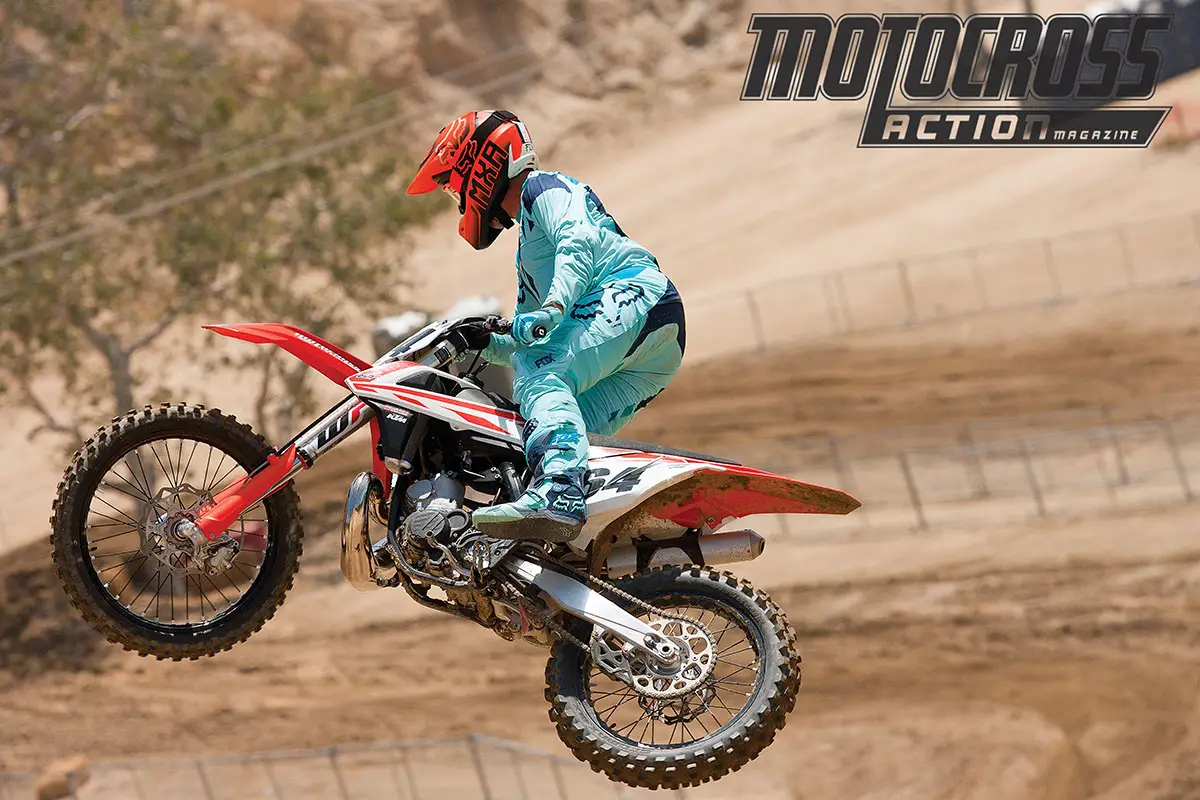
Q: HOW CAN YOU MOLD THE 250SX’S POWERBAND TO YOUR WANTS AND NEEDS?
A: This is an extremely potent powerband. It ramps up fast and needs to be short-shifted to stay in the meat of the power. Your initial impression of the engine will leave you wide-eyed with a grin from ear to ear; however, as the laps go by, you’ll find it hard to get power to the ground if the dirt isn’t loamy. KTM has installed an adjustable power valve on the 250SX. Here is how you adjust it.
On the starboard side of the engine, in front of the clutch cover, you will find the power-valve adjuster. It is the only part on the 250SX that calls for a square wrench (also known as a Robertson or Scrulox wrench). Since this odd tool doesn’t come in the KTM tool pack, we used a flat-bladed screwdriver to adjust it. By turning the square power-valve bolt (Robertson bolt), you are able to adjust the preload on the power-valve spring. Preload on the spring changes when the power valve opens.
To adjust the KTM 250SX power valve, you don’t need to loosen the two 6mm fasteners on either side of the Robertson adjuster. Be forewarned, this adjustment makes a huge difference with only small turns of the dial. We recommend using 1/4-turn increments (one turn in from all the way is the stock setting). Since our testers wanted to broaden the power of the 250SX for a more linear powerband, we turned the dial counterclockwise. We found the sweet spot at 3/4 turns, which allowed the power to track to the ground and pull each gear longer with more over-rev. Our less aggressive riders toned it down even more. If you dare, you can turn the PowerDial clockwise. The Mike Tyson-style hit might just throw you off the rear of the bike.
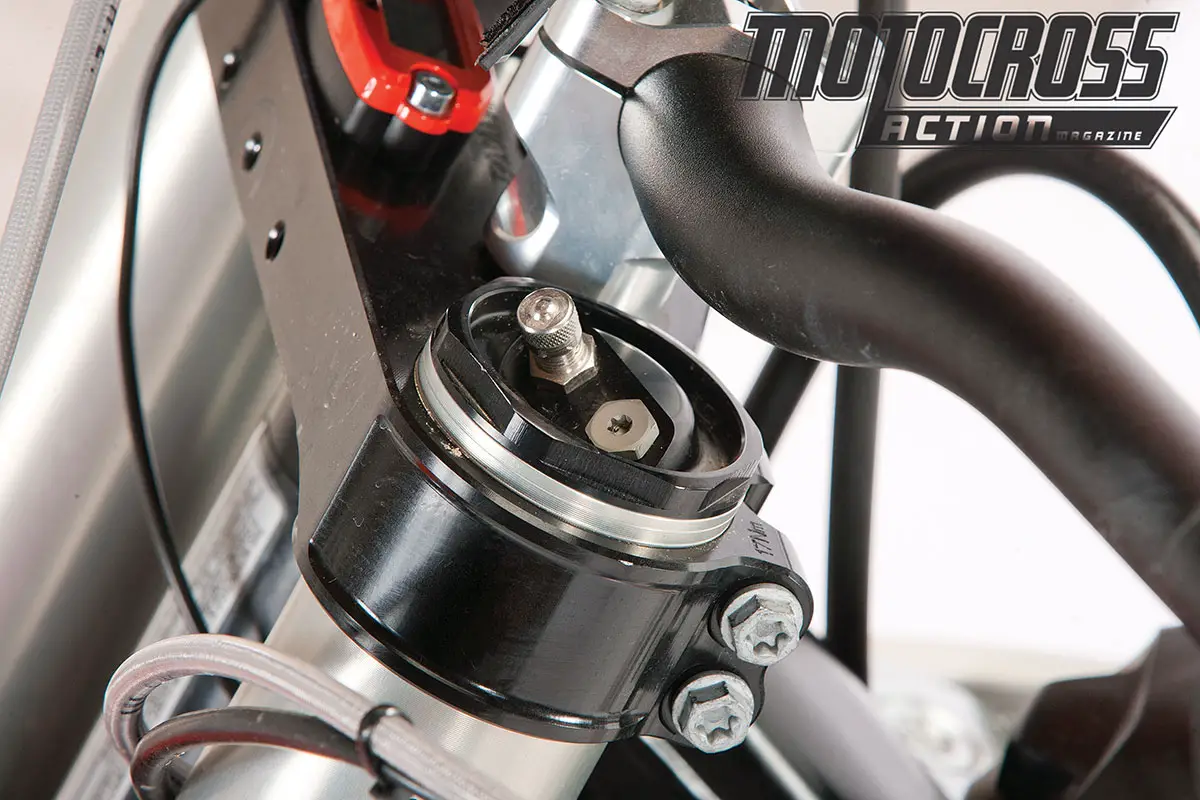
Q: WHAT IS THE ONE CHANGE EVERY 250SX OWNER SHOULD MAKE?
A: Stock gearing on the 250SX is 14/50. With the increased power mixed with the old gearbox, many test riders had issues with the shift from second to third gear. While backing off the power valve helped some, many test riders still wanted a broader spread. For these riders, the solution was to swap the stock 50-tooth rear sprocket for a taller 49. This smoothed out and lengthened the gap between gears. This is just a band-aid fix. KTM needs to rework the gear ratios to work in conjunction with the potent 250SX engine.
Q: WHAT ELSE CAN YOU DO TO MANAGE THE POWER?
A: Starve the engine of air. The MXA test riders have always been critical of Husqvarna’s restrictive airbox design, but in back-to-back tests, we found the Husqvarna version of the identical 250SX engine to be more manageable. So, we placed tape over the airbox vent on our KTM’s side panel. Yes, this strategy goes against the grain and looks crazy, but we wanted to see what would happen if we turned the KTM airbox into a Husqvarna airbox. Amazingly, the engine was calmed down. The hit was made more manageable, and the powerband revved out further. Even stranger, the handling improved. Should you try this? You could, because all it takes is a strip of duct tape and five minutes of your time. But, most test riders who wanted a mellower powerband unplugged the grey wire under the gas tank. Plugged into its white male/female connector the stock map is engaged, unplugged activates the mellow map.
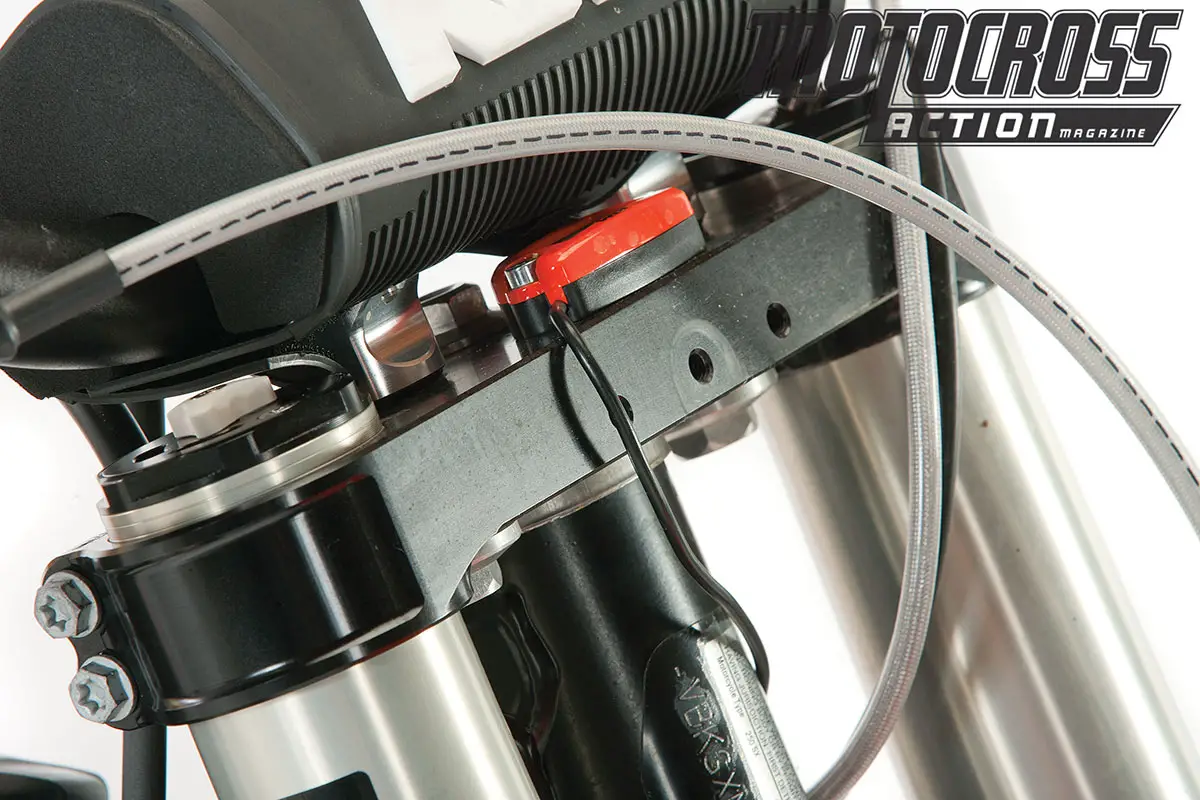
Q: HOW DO THE WP AER FORKS STACK UP AGAINST THE WP 4CS FORKS?
A: The WP AER air forks were first unveiled to American racers on the 2016 KTM Factory Editions. You might be surprised to hear us say this about a WP fork, but we really liked the 2016 WP AER fork. It was much better than the 2016 4CS fork, but it wasn’t perfect. We were confused as to why the AER forks on the Factory Editions were 12mm longer than the previous 4CS forks. With the forks set at the standard second line in the clamps, it felt like we were riding a chopper. So, to get the frame geometry back to where it was supposed to be, we slid the forks up until they hit the bars. It looked funny, but it worked on the 2016 Factory Editions.
The surprise came on the 2017 KTM 250SX. The fork legs are still longer, obvious by the fact that KTM added a third position line on the fork stanchion. The bike over-steered when we slid the fork up to compensate for the extra 12mm in length. Every MXA test rider slid the forks back down in the triple clamps, eventually ending up with the forks set on the second line in the clamps. At this setting the 250SX turned on a dime. Additionally, the weird clank that the AER forks on the 2016 Factory Editions exhibited on slap down jumps was gone. What changed? After getting test reports about the Factory Edition forks, WP refined the way the forks ramp up. These changes allowed the fork to sit lower in the stroke. Second, WP tapered the fork-tube stanchions by 1mm. One millimeter may not seem like much, but the difference allowed the forks to flex more laterally, which allowed the 250SX to work in unison with the rest of the bike. We think that the 2017 WP AER fork is the best air fork on the market. Why? Because it is a simple design that only has one air-pressure setting. It is easier to use than the overly complicated Showa and Kayaba air forks. Once you have the correct air pressure for your weight, speed and track, adjust the compression and rebound on the right fork leg. The clickers make a big difference.
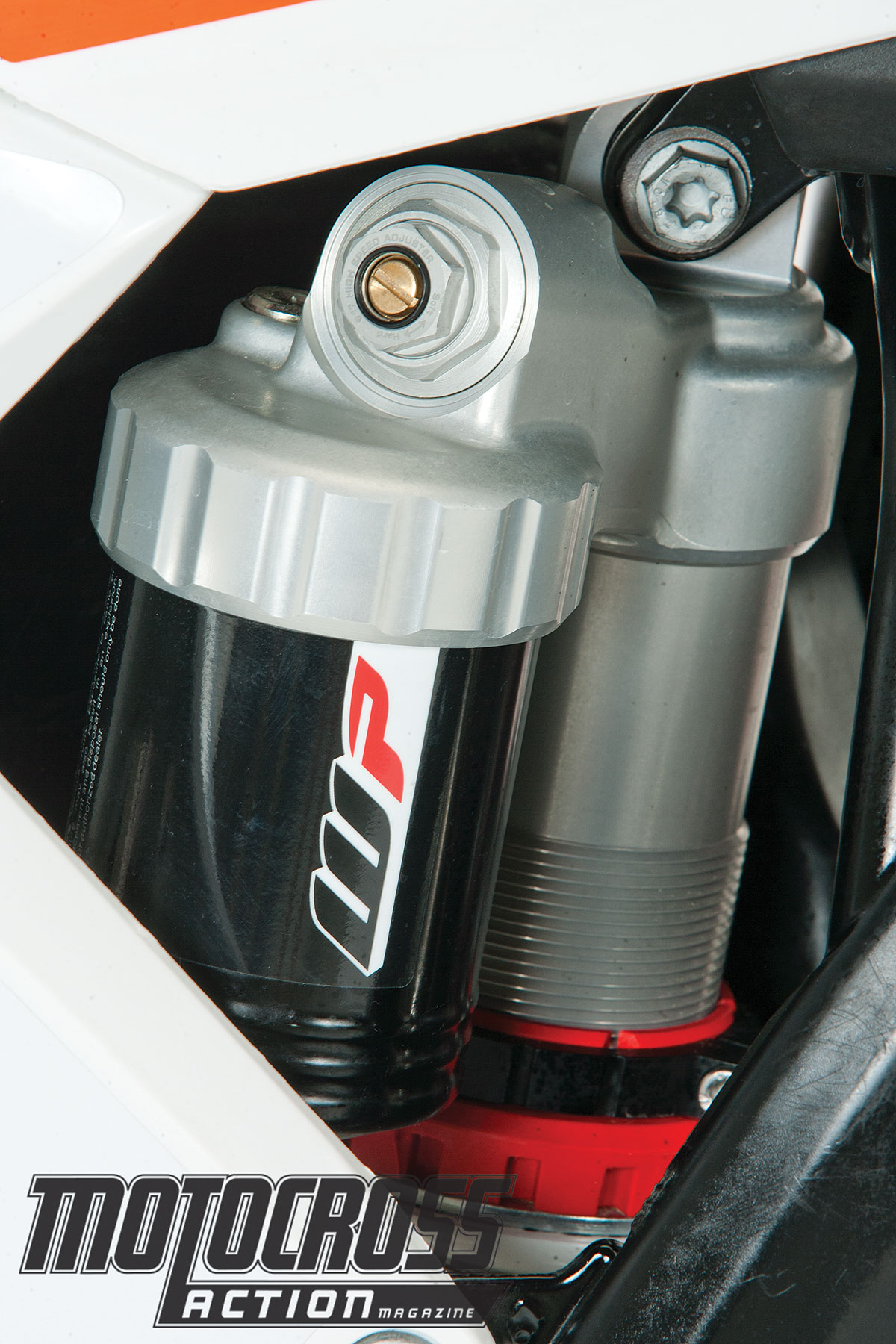
Q: WHAT DID WE HATE?
A: The hate list:
(1) Gas-cap vent hose. KTM’s vent hose gets twisted in a knot when you take the gas cap off to fill the tank.
(2) Sprocket bolts. Watch them like a hawk, as they come loose quickly.
(3) Gearing. The gear ratio from second to third is too close. We went with taller gearing.
(4) Shock collar. The plastic shock collar gets chewed up. We recommend the easy-to-use Xtrig preload adjuster (although the shock has to be disassembled to install it). Or, you can use a long flat-bladed screwdriver leveraged against the frame as a pry bar on the preload ring.
(5) Spokes. We don’t know why the spoke by the rim lock always comes loose, but it does—every time we ride. And, it indicates that all the spokes will be loose in short order. The rims don’t have a brand name on them, but KTM they were stamped as Takasago Excels minus the “Excel” logo.
(6) Transmission. The old tranny needs to be matched to the potent power of the engine.
Q: WHAT DID WE LIKE?
A: The like list:
(1) Brakes. They are not as strong as last year’s stoppers, but they are still the best in the class.
(2) Hydraulic clutch. KTM’s self-adjusting, hydraulic, Belleville-washer clutch is way ahead of the Japanese clutches. It is the best clutch in the sport.
(3) Airbox. We don’t think changing an air filter could get any simpler. Plus, with a few strips of tape, you can turn it into a tuning tool.
(4) Forks. We love the WP AER air forks.
(5) Tires. The 250SX comes with our favorite tires, Dunlop Geomax MX3S’s.
(6) Power valve. The power valve is a great way to refine the power delivery. But, order a $95 Kreft PowerDial so you can make incremental changes in seconds without the need for a Robertson or Scrulox wrench.
(7) Weight. The AER air forks are 3.6 pounds lighter than the previous 4CS forks, while the engine, frame and swingarm are also weight-savers (although the new triple clamps add some of that weight back). The 2017 KTM 250SX hits the scales at 211 pounds without fuel.
Q: WHAT DO WE REALLY THINK?
A: We have long awaited this bike. The new generation chassis with the reworked 250SX engine and the WP AER forks make for a combination that puts the old-dog YZ250 out to pasture. KTM is making two-strokes fun again. The 2017 250SX is something you look forward to riding each and every time. This bike is not just good, it’s great, once you dial it in.
MXA’S KTM 250SX SETUP SPECS

This is how we set up our 2017 KTM 250SX for racing. We offer it as a guide to help you find your own sweet spot.
WP FORK SETTINGS
Out with the old and in with the new. WP AER air forks are here to stay. As a general rule, first find an air pressure that you like, then start adjusting the clickers. We recommend adjusting the air pressure in 2-pound increments. While the stock air pressure is 147 psi, we had riders who liked it as low as 143 psi and as high as 154 psi. With only one air-pressure adjustment, changes can be made in half the time it takes to adjust a Showa or Kayaba air fork. Plus, KTM gives you a digital air pump when you buy the bike. It makes it easier to find your happy place. These are the settings we ran on the 2017 KTM 250SX (stock settings in parentheses):
Air pressure: 144 psi (147 psi)
Compression: 23 clicks out (15 clicks out)
Rebound: 19 clicks out (15 clicks out)
Fork height: 2nd line
Notes: On big hits at pressures below 144, the forks will bottom out (unless you add oil to the fork). Anything above 144 and our testers had no issues with bottoming resistance.
WP SHOCK SETTINGS
The KTM shock has a good setting. We spent most of our time dialing in the forks, although sag played a big part in balancing out the bike. We were all over the map, going as low as 115mm and as high as 100mm. Most test riders split the difference at 107mm, although the sweet spot is between 102mm and 108mm, depending on the rider and track. For hard-core racing, we recommend this shock setup for the 2017 KTM 250SX (stock specs are in parentheses):
Spring rate: 4.2 N/m
Hi-compression: 1-1/4 turns out (2 turns out)
Lo-compression: 8 clicks out (15 out)
Rebound: 14 clicks out (15 out)
Race sag: 107mm (110mm)
Notes: For riders below 185 pounds, start turning out the low-speed compression to get the rear end to settle.
MIKUNI TMX 38 JETTING SPEC
Here’s what we ran in our 38mm PWK (stock settings in parentheses):
Main jet: 450 (440)
Pilot: 42.5
Needle: 43-73
Clip: 3rd
Air screw: 2-1/2 turns out (1-1/5 turns)



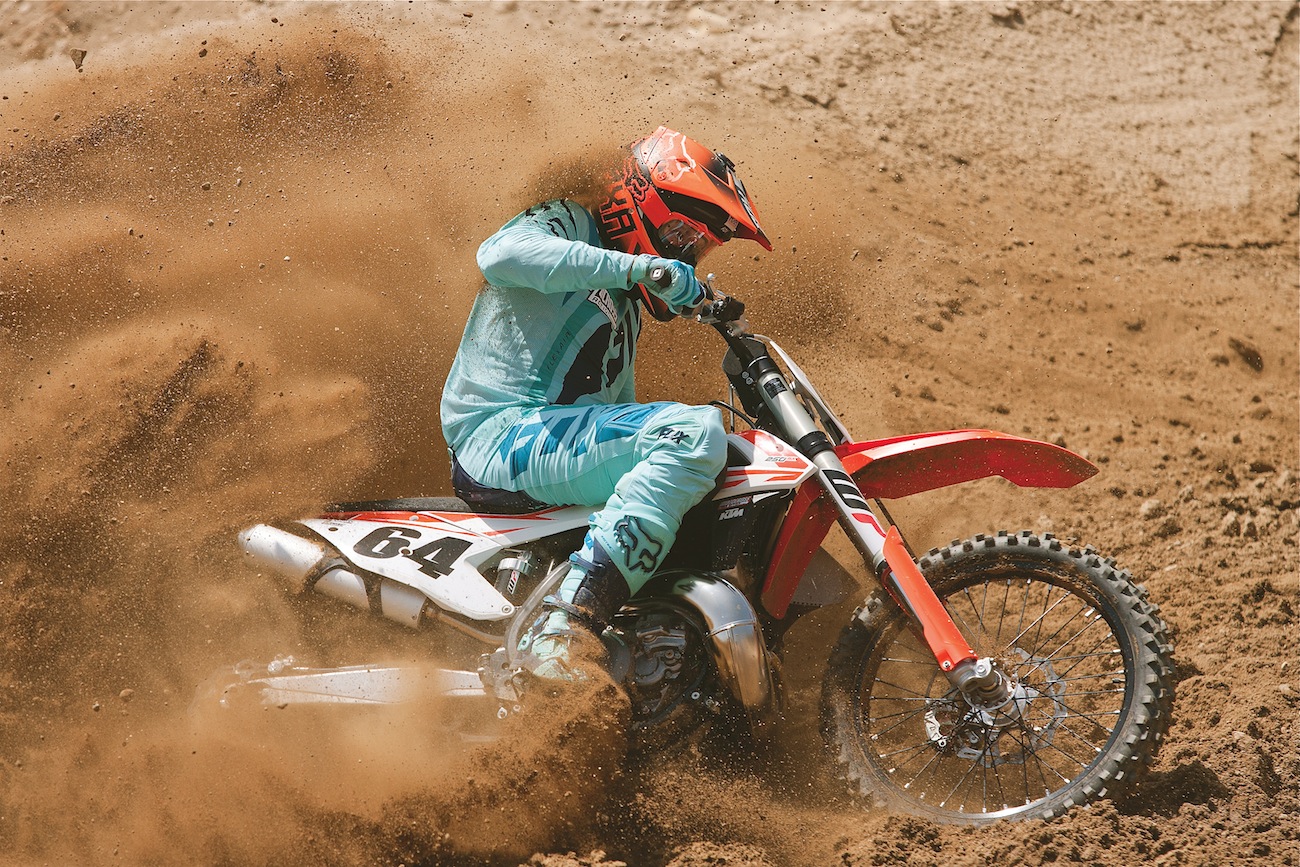




Comments are closed.